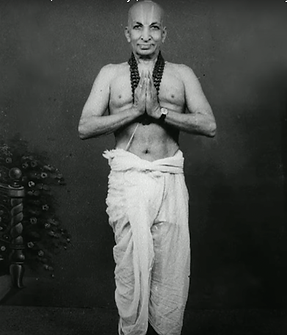


Discover the profound lineage of Ashtanga Yoga, where knowledge is passed down from guru to student through the ancient tradition of Parampara. Learn about the roots and wisdom behind our authentic yoga practice.
Ashtanga Yoga is an ancient system of Yoga that was taught by Vamana Rishi in the Yoga Korunta. This text was imparted to Sri T. Krishnamacharya in the early 1900’s by his Guru Rama Mohan Brahmachari, and was later passed down to Sh. Pattabhi Jois during the duration of his studies with Sh. Krishnamacharya, beginning in 1927. Sh. Pattabhi Jois further passed it to Sh. R Sharath Jois.
The following are aspects as the main components of Ashtanga Yoga.
Vinyasa:
Ashtanga is Vinyasa krama Yoga. Vinyasa means body movement with respect to breath. What is breath? Breath is inhale(puraka) and exhale(rechaka). So, for every pose when body moves, it moves in inhale, stay and then again moves in exhale, stay, in an ongoing cycle. Krama means Sequence. Ashtanga Yoga asanas are arranged in a sequence. Each asana prepares the body for the next asana. Within one asana itself, body movement flows in a sequence with Sanskrit count, ekam, dve, trini, chatvari and so on. For example, in Surya Namskar A there are nine vinyasas. The first vinyasa is inhaling while raising your arms over your head, and putting your hands together with hastagraha drishti; the second is exhaling while bending forward with nasagraha drishti, placing your hands next to your feet, etc. In this way all asanas are assigned a certain number of vinyasas.
Vinyasa results in making blood hot, making it thin so blood can circulate freely around all joints, internal organs and removes the body pains, impurities & toxins in form of sweat and diseases. When one follows Vinayasa krama Yoga, body becomes healthy, pure and strong. After body, next purification is of nervous system and then the sense organs. Through will power and diligent practice, these can be attained.
Sage Vamana says: Vina Vinyasa yogena asanadin na karayet means Do not do asana without vinyasa.
Practicing with proper knowledge, method makes the practice easy else difficult to progress.
Tristhana:
Tri means three. Trishtana method is flowing the attention at three places while performing Vinyasa Krama Yoga: Posture, Breathing and Gaze. These three are very important for yoga practice, and cover three levels of purification: the body, nervous system and mind. They are always performed in conjunction with each other.
Asanas purify, strengthen and give flexibility to the body. Breathing should be steady and even, the length of the inhale should be the same length as the exhale. Breathing in this manner purifies the nervous system. Dristhi is the place where you look while in the asana. There are nine dristhis: the nose/nasagraha, between the eyebrows/bhrumadhya, navel/nabhi chakra, thumb/angusht-madhyai, hands/hastagraha, feet/padhyoragrayai, up/antara, right side & left side/parsva and forward/sama. Dristhi purifies and stabilizes the functioning of the mind.
For cleaning the body internally two elements are necessary, air and fire. The place of fire in our bodies is four inches below the navel. This is the standing place of our life force. In order for fire to burn, air is necessary, hence the necessity of the breath. If you stoke a fire with a blower, evenness is required so that the flame is not smothered out, or blown out of control.
The same method stands for the breath. Long even breaths will strengthen our internal fire, increasing heat in the body which in turn heats the blood for physical purification, and burns away impurities in the nervous system as well. Long even breathing increases the internal fire and strengthens the nervous system in a controlled manner and at an even pace. When this fire is strengthened, our digestion, health and life span all increase. Uneven inhalation and exhalation, or breathing too rapidly, will imbalance the beating of the heart, throwing off both the physical body and autonomic nervous system.
An important component of the breathing system is mula and uddiyana bandha. These are the anal and lower abdominal locks which seal in energy, give lightness, strength and health to the body, and help to build a strong internal fire. Without bandhas, breathing will not be correct, and the asanas will give no benefit. When mula bandha is perfect, mind control is automatic.
The six poisons:
In the yoga shastra it is said that God dwells in our heart in the form of light, but this light is covered by six poisons:
kama/desire
krodha/anger
moha/delusion
lobha/greed
matsarya/envy
mada/sloth
When yoga practice is sustained with great diligence and dedication over a long period of time, the heat generated from it burns away these poisons, and the light of our true inner nature shines forth.
Yoga teaches discipline in one's life and gives joyful energetic body, loving compassionate heart and restful alert stabilized mind directed towards the Inner Self.

